Meng Hua
Secure Transmission for Cell-Free Symbiotic Radio Communications with Movable Antenna: Continuous and Discrete Positioning Designs
Aug 09, 2025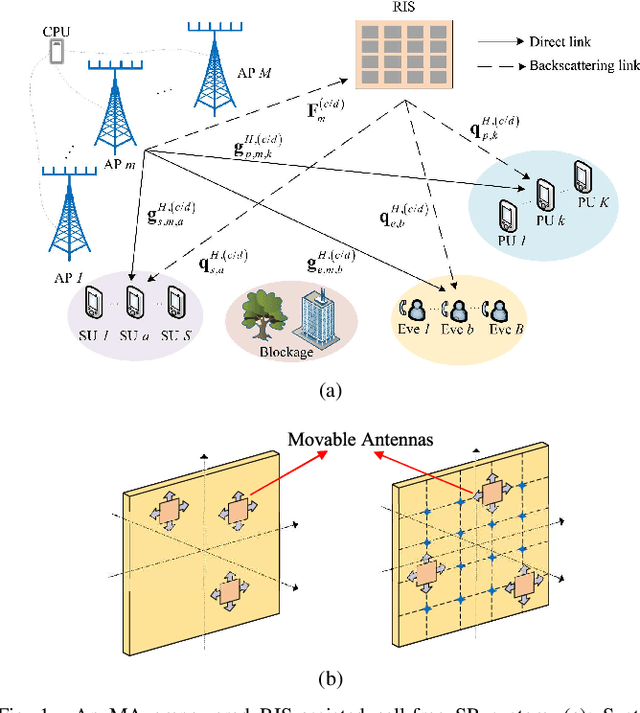
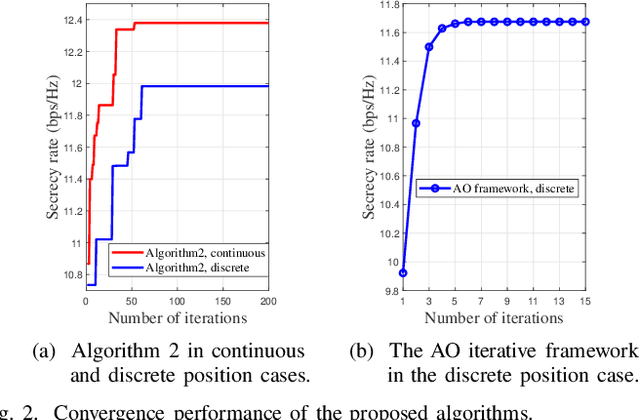
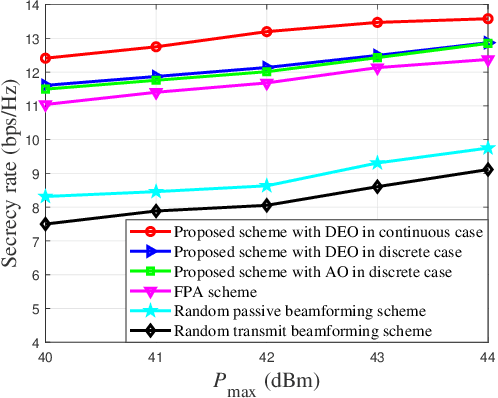
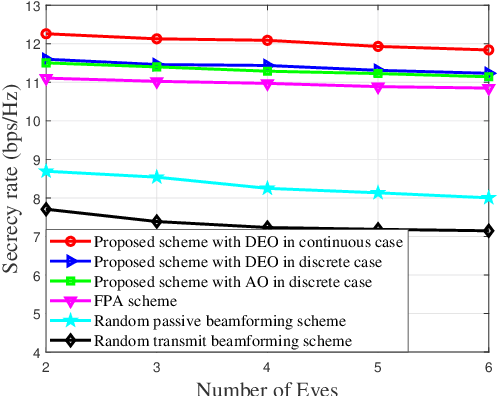
Abstract:In this paper, we study a movable antenna (MA) empowered secure transmission scheme for reconfigurable intelligent surface (RIS) aided cell-free symbiotic radio (SR) system. Specifically, the MAs deployed at distributed access points (APs) work collaboratively with the RIS to establish high-quality propagation links for both primary and secondary transmissions, as well as suppressing the risk of eavesdropping on confidential primary information. We consider both continuous and discrete MA position cases and maximize the secrecy rate of primary transmission under the secondary transmission constraints, respectively. For the continuous position case, we propose a two-layer iterative optimization method based on differential evolution with one-in-one representation (DEO), to find a high-quality solution with relatively moderate computational complexity. For the discrete position case, we first extend the DEO based iterative framework by introducing the mapping and determination operations to handle the characteristic of discrete MA positions. To further reduce the computational complexity, we then design an alternating optimization (AO) iterative framework to solve all variables within a single layer. In particular, we develop an efficient strategy to derive the sub-optimal solution for the discrete MA positions, superseding the DEO-based method. Numerical results validate the effectiveness of the proposed MA empowered secure transmission scheme along with its optimization algorithms.
Intelligent Metasurface-Enabled Integrated Sensing and Communication: Unified Framework and Key Technologies
Jun 16, 2025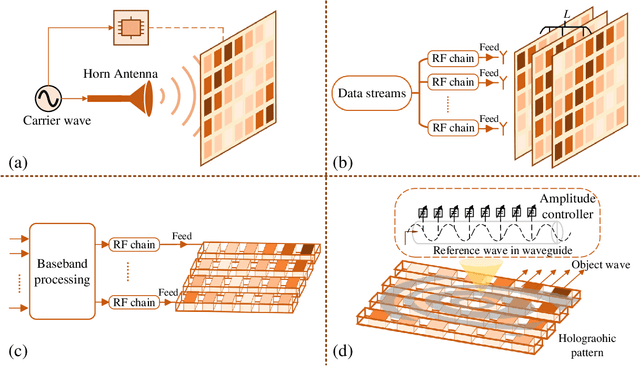
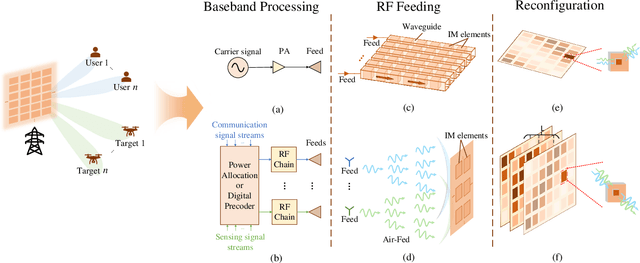
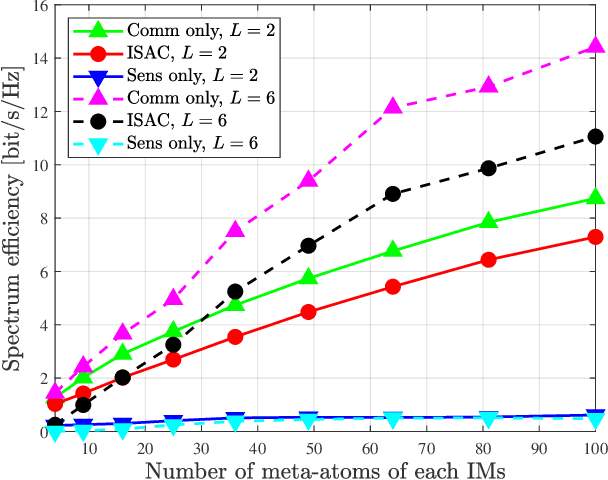
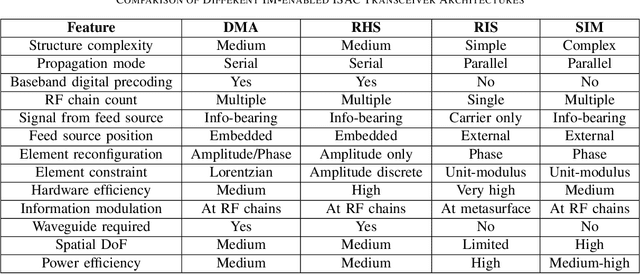
Abstract:As the demand for ubiquitous connectivity and high-precision environmental awareness grows, integrated sensing and communication (ISAC) has emerged as a key technology for sixth-generation (6G) wireless networks. Intelligent metasurfaces (IMs) have also been widely adopted in ISAC scenarios due to their efficient, programmable control over electromagnetic waves. This provides a versatile solution that meets the dual-function requirements of next-generation networks. Although reconfigurable intelligent surfaces (RISs) have been extensively studied for manipulating the propagation channel between base and mobile stations, the full potential of IMs in ISAC transceiver design remains under-explored. Against this backdrop, this article explores emerging IM-enabled transceiver designs for ISAC systems. It begins with an overview of representative IM architectures, their unique principles, and their inherent advantages in EM wave manipulation. Next, a unified ISAC framework is established to systematically model the design and derivation of diverse IM-enabled transceiver structures. This lays the foundation for performance optimization, trade-offs, and analysis. The paper then discusses several critical technologies for IM-enabled ISAC transceivers, including dedicated channel modeling, effective channel estimation, tailored beamforming strategies, and dual-functional waveform design.
Realizing Fully-Connected Layers Over the Air via Reconfigurable Intelligent Surfaces
May 02, 2025Abstract:By leveraging the waveform superposition property of the multiple access channel, over-the-air computation (AirComp) enables the execution of digital computations through analog means in the wireless domain, leading to faster processing and reduced latency. In this paper, we propose a novel approach to implement a neural network (NN) consisting of digital fully connected (FC) layers using physically reconfigurable hardware. Specifically, we investigate reconfigurable intelligent surfaces (RISs)-assisted multiple-input multiple-output (MIMO) systems to emulate the functionality of a NN for over-the-air inference. In this setup, both the RIS and the transceiver are jointly configured to manipulate the ambient wireless propagation environment, effectively reproducing the adjustable weights of a digital FC layer. We refer to this new computational paradigm as \textit{AirFC}. We formulate an imitation error minimization problem between the effective channel created by RIS and a target FC layer by jointly optimizing over-the-air parameters. To solve this non-convex optimization problem, an extremely low-complexity alternating optimization algorithm is proposed, where semi-closed-form/closed-form solutions for all optimization variables are derived. Simulation results show that the RIS-assisted MIMO-based AirFC can achieve competitive classification accuracy. Furthermore, it is also shown that a multi-RIS configuration significantly outperforms a single-RIS setup, particularly in line-of-sight (LoS)-dominated channels.
Over-the-Air Inference over Multi-hop MIMO Networks
May 01, 2025Abstract:A novel over-the-air machine learning framework over multi-hop multiple-input and multiple-output (MIMO) networks is proposed. The core idea is to imitate fully connected (FC) neural network layers using multiple MIMO channels by carefully designing the precoding matrices at the transmitting nodes. A neural network dubbed PrototypeNet is employed consisting of multiple FC layers, with the number of neurons of each layer equal to the number of antennas of the corresponding terminal. To achieve satisfactory performance, we train PrototypeNet based on a customized loss function consisting of classification error and the power of latent vectors to satisfy transmit power constraints, with noise injection during training. Precoding matrices for each hop are then obtained by solving an optimization problem. We also propose a multiple-block extension when the number of antennas is limited. Numerical results verify that the proposed over-the-air transmission scheme can achieve satisfactory classification accuracy under a power constraint. The results also show that higher classification accuracy can be achieved with an increasing number of hops at a modest signal-to-noise ratio (SNR).
Robust Transmission Design for Reconfigurable Intelligent Surface and Movable Antenna Enabled Symbiotic Radio Communications
Apr 23, 2025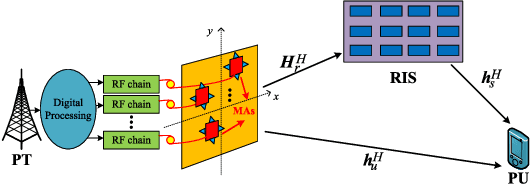
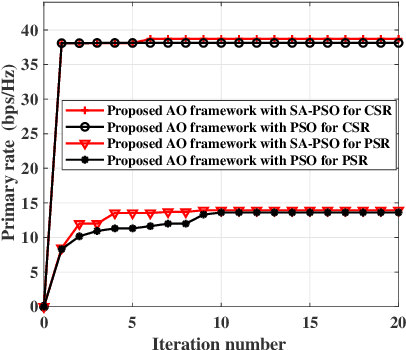
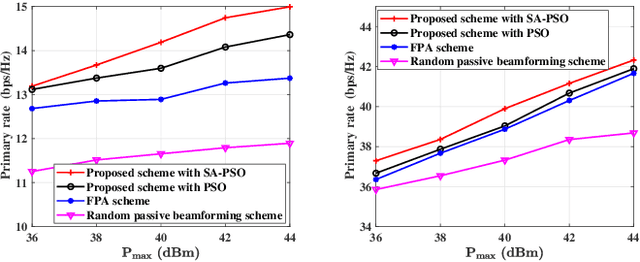
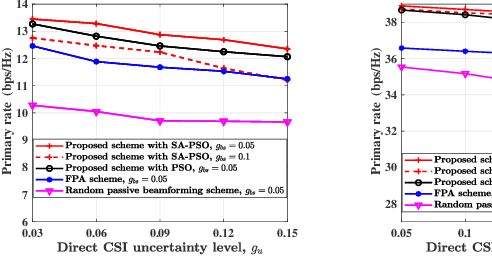
Abstract:This paper explores the application of movable antenna (MA), a cutting-edge technology with the capability of altering antenna positions, in a symbiotic radio (SR) system enabled by reconfigurable intelligent surface (RIS). The goal is to fully exploit the capabilities of both MA and RIS, constructing a better transmission environment for the co-existing primary and secondary transmission systems. For both parasitic SR (PSR) and commensal SR (CSR) scenarios with the channel uncertainties experienced by all transmission links, we design a robust transmission scheme with the goal of maximizing the primary rate while ensuring the secondary transmission quality. To address the maximization problem with thorny non-convex characteristics, we propose an alternating optimization framework that utilizes the General S-Procedure, General Sign-Definiteness Principle, successive convex approximation (SCA), and simulated annealing (SA) improved particle swarm optimization (SA-PSO) algorithms. Numerical results validate that the CSR scenario significantly outperforms the PSR scenario in terms of primary rate, and also show that compared to the fixed-position antenna scheme, the proposed MA scheme can increase the primary rate by 1.62 bps/Hz and 2.37 bps/Hz for the PSR and CSR scenarios, respectively.
Element-Grouping Strategy for Intelligent Reflecting Surface: Performance Analysis and Algorithm Optimization
Apr 22, 2025Abstract:As a revolutionary paradigm for intelligently controlling wireless channels, intelligent reflecting surface (IRS) has emerged as a promising technology for future sixth-generation (6G) wireless communications. While IRS-aided communication systems can achieve attractive high channel gains, existing schemes require plenty of IRS elements to mitigate the ``multiplicative fading'' effect in cascaded channels, leading to high complexity for real-time beamforming and high signaling overhead for channel estimation. In this paper, the concept of sustainable intelligent element-grouping IRS (IEG-IRS) is proposed to overcome those fundamental bottlenecks. Specifically, based on the statistical channel state information (S-CSI), the proposed grouping strategy intelligently pre-divide the IEG-IRS elements into multiple groups based on the beam-domain grouping method, with each group sharing the common reflection coefficient and being optimized in real time using the instantaneous channel state information (I-CSI). Then, we further analyze the asymptotic performance of the IEG-IRS to reveal the substantial capacity gain in an extremely large-scale IRS (XL-IRS) aided single-user single-input single-output (SU-SISO) system. In particular, when a line-of-sight (LoS) component exists, it demonstrates that the combined cascaded link can be considered as a ``deterministic virtual LoS'' channel, resulting in a sustainable squared array gain achieved by the IEG-IRS. Finally, we formulate a weighted-sum-rate (WSR) maximization problem for an IEG-IRS-aided multiuser multiple-input single-output (MU-MISO) system and a two-stage algorithm for optimizing the beam-domain grouping strategy and the multi-user active-passive beamforming is proposed.
Beamforming Design for Intelligent Reffecting Surface Aided Near-Field THz Communications
Oct 11, 2024



Abstract:Intelligent reflecting surface (IRS) operating in the terahertz (THz) band has recently gained considerable interest due to its high spectrum bandwidth. Due to the exploitation of large scale of IRS, there is a high probability that the transceivers will be situated within the near-field region of the IRS. Thus, the near-field beam split effect poses a major challenge for the design of wideband IRS beamforming, which causes the radiation beam to deviate from its intended location, leading to significant gain losses and limiting the efficient use of available bandwidths. While delay-based IRS has emerged as a potential solution, current beamforming schemes generally assume unbounded range time delays (TDs). In this letter, we first investigate the near-field beam split issue at the IRS. Then, we extend the piece-wise far-field model to the IRS, based on which, a double-layer delta-delay (DLDD) IRS beamforming scheme is proposed. Specifically, we employ an element-grouping strategy and the TD imposed on each sub-surface of IRS is achieved by a series of TD modules. This method significantly reduces the required range of TDs. Numerical results show that the proposed DLDD IRS beamforming scheme can effectively mitigate the near-field beam split and achieve near-optimal performance.
The Career Interests of Large Language Models
Jul 11, 2024



Abstract:Recent advancements in Large Language Models (LLMs) have significantly extended their capabilities, evolving from basic text generation to complex, human-like interactions. In light of the possibilities that LLMs could assume significant workplace responsibilities, it becomes imminently necessary to explore LLMs' capacities as professional assistants. This study focuses on the aspect of career interests by applying the Occupation Network's Interest Profiler short form to LLMs as if they were human participants and investigates their hypothetical career interests and competence, examining how these vary with language changes and model advancements. We analyzed the answers using a general linear mixed model approach and found distinct career interest inclinations among LLMs, particularly towards the social and artistic domains. Interestingly, these preferences did not align with the occupations where LLMs exhibited higher competence. This novel approach of using psychometric instruments and sophisticated statistical tools on LLMs unveils fresh perspectives on their integration into professional environments, highlighting human-like tendencies and promoting a reevaluation of LLMs' self-perception and competency alignment in the workforce.
Intelligent Reflecting Surface Aided AirComp: Multi-Timescale Design and Performance Analysis
May 09, 2024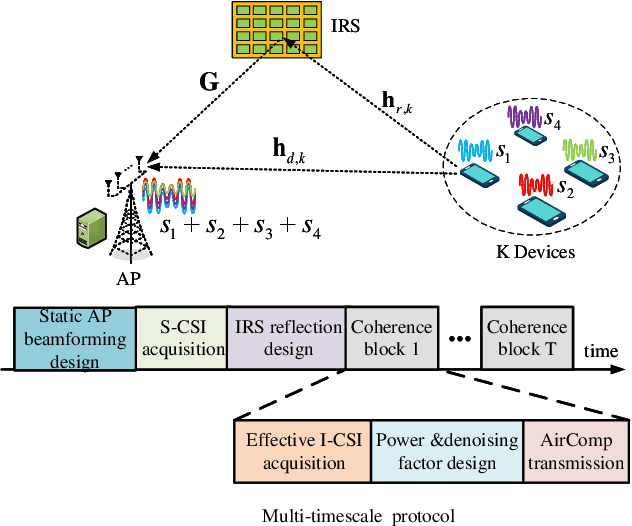

Abstract:The integration of intelligent reflecting surface (IRS) into over-the-air computation (AirComp) is an effective solution for reducing the computational mean squared error (MSE) via its high passive beamforming gain. Prior works on IRS aided AirComp generally rely on the full instantaneous channel state information (I-CSI), which is not applicable to large-scale systems due to its heavy signalling overhead. To address this issue, we propose a novel multi-timescale transmission protocol. In particular, the receive beamforming at the access point (AP) is pre-determined based on the static angle information and the IRS phase-shifts are optimized relying on the long-term statistical CSI. With the obtained AP receive beamforming and IRS phase-shifts, the effective low-dimensional I-CSI is exploited to determine devices' transmit power in each coherence block, thus substantially reducing the signalling overhead. Theoretical analysis unveils that the achievable MSE scales on the order of ${\cal O}\left( {K/\left( {{N^2}M} \right)} \right)$, where $M$, $N$, and $K$ are the number of AP antennas, IRS elements, and devices, respectively. We also prove that the channel-inversion power control is asymptotically optimal for large $N$, which reveals that the full power transmission policy is not needed for lowering the power consumption of energy-limited devices.
Intelligent Reflecting Surface Aided Target Localization With Unknown Transceiver-IRS Channel State Information
Apr 08, 2024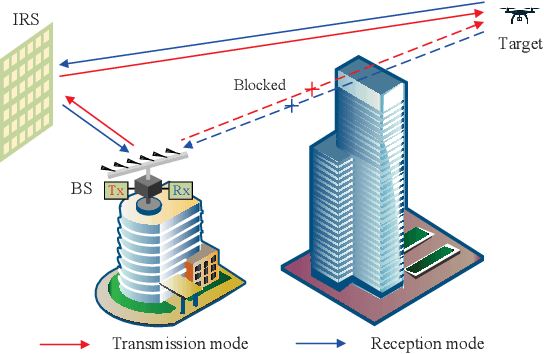
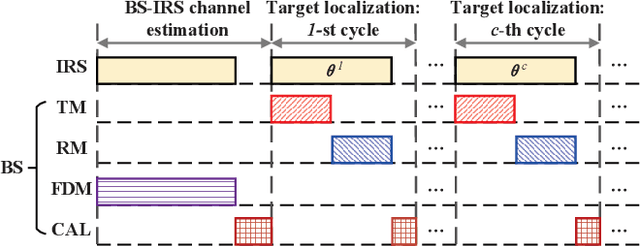
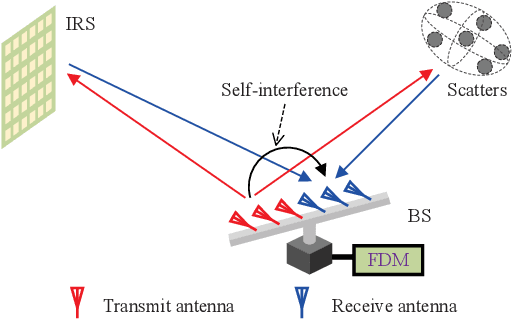
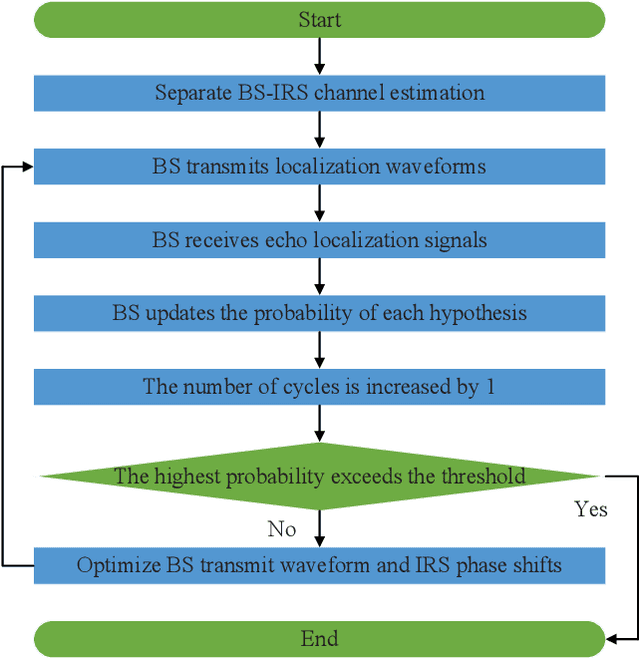
Abstract:Integrating wireless sensing capabilities into base stations (BSs) has become a widespread trend in the future beyond fifth-generation (B5G)/sixth-generation (6G) wireless networks. In this paper, we investigate intelligent reflecting surface (IRS) enabled wireless localization, in which an IRS is deployed to assist a BS in locating a target in its non-line-of-sight (NLoS) region. In particular, we consider the case where the BS-IRS channel state information (CSI) is unknown. Specifically, we first propose a separate BS-IRS channel estimation scheme in which the BS operates in full-duplex mode (FDM), i.e., a portion of the BS antennas send downlink pilot signals to the IRS, while the remaining BS antennas receive the uplink pilot signals reflected by the IRS. However, we can only obtain an incomplete BS-IRS channel matrix based on our developed iterative coordinate descent-based channel estimation algorithm due to the "sign ambiguity issue". Then, we employ the multiple hypotheses testing framework to perform target localization based on the incomplete estimated channel, in which the probability of each hypothesis is updated using Bayesian inference at each cycle. Moreover, we formulate a joint BS transmit waveform and IRS phase shifts optimization problem to improve the target localization performance by maximizing the weighted sum distance between each two hypotheses. However, the objective function is essentially a quartic function of the IRS phase shift vector, thus motivating us to resort to the penalty-based method to tackle this challenge. Simulation results validate the effectiveness of our proposed target localization scheme and show that the scheme's performance can be further improved by finely designing the BS transmit waveform and IRS phase shifts intending to maximize the weighted sum distance between different hypotheses.
 Add to Chrome
Add to Chrome Add to Firefox
Add to Firefox Add to Edge
Add to Edge